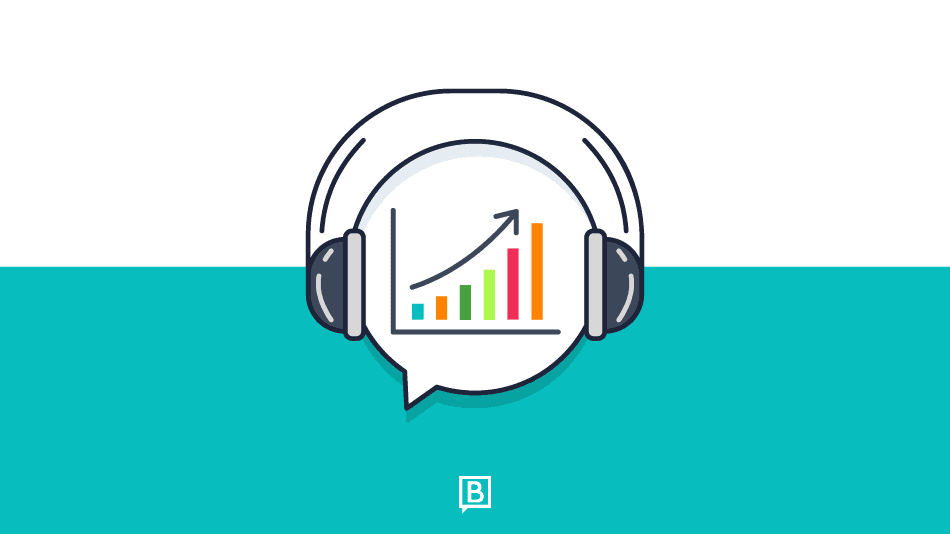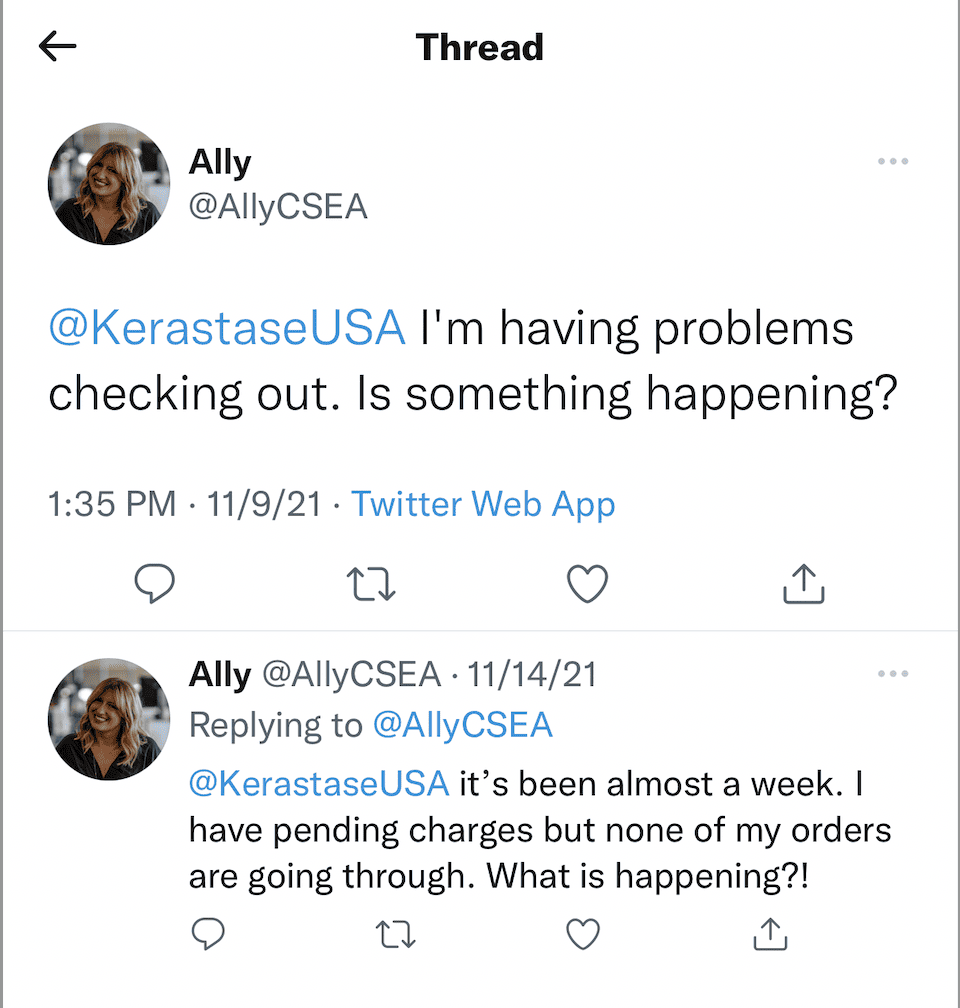Social media has transformed from a digital meeting place into a powerful business tool. And yet, so few brands are using it that way.
While many companies have embraced social listening—tracking mentions and monitoring conversations—few go beyond it.
Social media intelligence (SMI) takes things a step further, turning raw data into meaningful insights that drive revenue.
But how does it work? And how can businesses leverage it to create revenue-generating conversations? Let’s dive in.
What Is Social Media Intelligence?
Most people hear “intelligence” and think data. Reports. Numbers. Dashboards full of charts. But here’s the thing—data isn’t intelligence.
[Enter “GASP!” face.]
Raw numbers don’t magically tell you what to do next. Intelligence is the part where you actually interpret the data and turn it into something useful.
It’s about making sense of the noise and saying, “Here’s what this means, and here’s what we need to do next to achieve X.”
So let’s be clear: Social media intelligence isn’t just collecting data—it’s knowing how to read between the lines, uncover opportunities, and take action.
Definition & Key Components
Social media intelligence is the process of gathering, analyzing, and applying insights from social media data.
It combines artificial intelligence (AI), big data, and analytics to go beyond just monitoring mentions.
It uncovers things like:
- Industry trends
- Consumer sentiment
- Competitive analysis
- Potential revenue opportunities
How It Differs from Social Listening
While social listening focuses on hearing what’s being said, social intelligence focuses on understanding why it’s being said and what to do with that information.
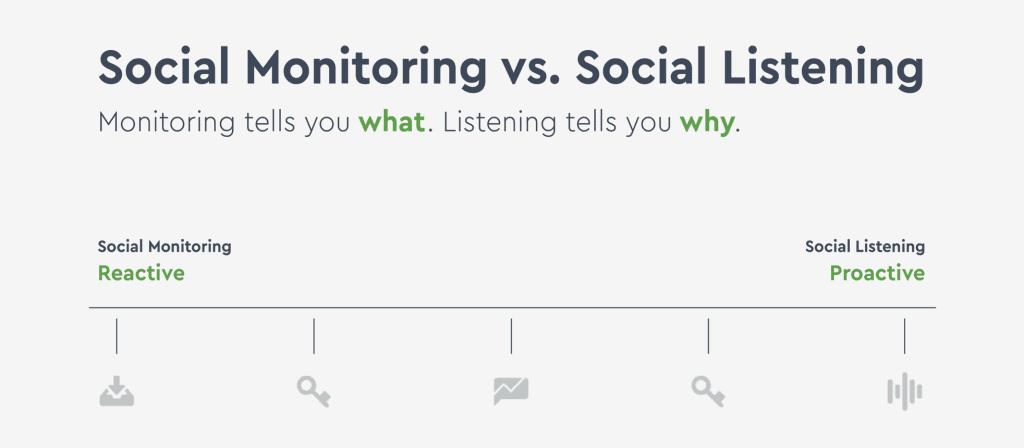
Instead of passively monitoring conversations, businesses use the data they collect from social listening to create social media intelligence (SMI). Then, that social intelligence shapes marketing, sales, and customer experience strategies.
Example: From Passive Monitoring to Strategic Action
When we first started working with this brand — a major consumer electronics brand — they were only monitoring their direct mentions. This means they were missing out on sales opportunities and critical customer feedback happening outside their inbox.
For a quick visual, here’s a direct mention versus an indirect mention with Apple Music as the example.
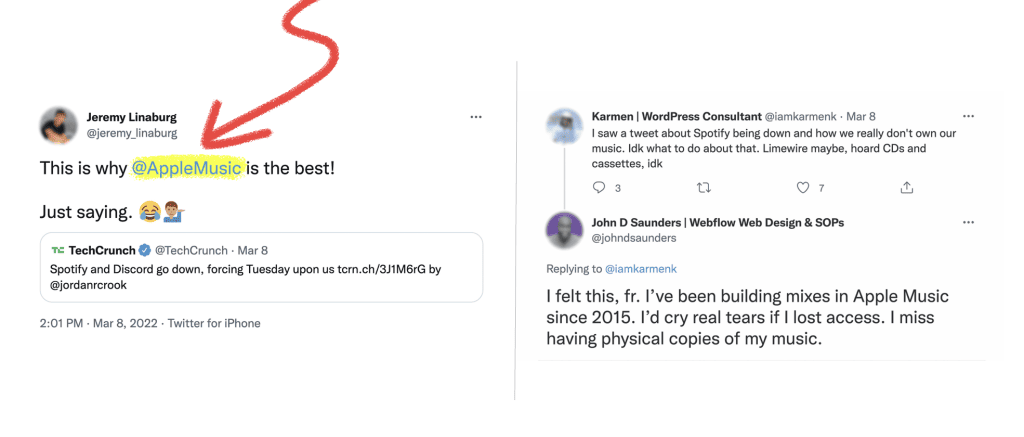
Enter B Squared Media. We set up a social intelligence and social listening strategy that didn’t just track @mentions—it captured dark social conversations where potential customers were discussing product pain points, asking for recommendations, and even mentioning competitors.
In the Apple example above, that would be the conversation that’s happening on the right.
What we found? People were actively talking about their printer struggles—but weren’t @mentioning the brand. A key phrase kept popping up: “What’s the best printer for [X]?”
The company wasn’t responding to these convos before, because they weren’t focused on proactive social media intelligence. We changed that.
Instead of just monitoring, we acted. We engaged in real-time conversations, connected these potential buyers with the right product information, and even worked with the brand’s marketing team to highlight their customer and would-be customers conversations effectively.
The result? A nearly 4,000+% increase in social-driven brand conversations!

This is what true social media intelligence looks like. Not just finding conversations—but leveraging them to shape marketing, sales, and customer experience (CX) strategies.
The Evolution of Social Media Monitoring
Once upon a time, social media monitoring was basically glorified eavesdropping. Brands would set up alerts, see who mentioned them, and—if they were feeling ambitious—maybe even respond.
But here’s the reality: Knowing what’s being said isn’t enough. The real power comes from knowing what to do with that information.
Thanks to AI and advanced analytics, social monitoring has leveled up. Now, brands aren’t just tracking mentions; they’re detecting trends before they go mainstream, predicting customer behavior, and tailoring marketing strategies with precision.
It’s no longer just about hearing the conversation. It’s about using that insight to drive real business decisions. You know … social media intelligence!
From Listening to Actionable Intelligence
Traditional social monitoring provided businesses with basic alerts about mentions.
However, with advancements in social listening, AI, and analytics, companies can now detect emerging trends, predict customer behavior, and personalize their marketing strategies.

Why Businesses Need Deeper Insights (aka Social Media Intelligence)
Consumers expect brands to engage with them on a personal level. In fact, nearly two thirds (64%) of consumers want brands to connect with them, while just under half (49%) expect brands to bring people together toward a common goal.
A generic response isn’t enough.
Social intelligence helps businesses tailor their approach by analyzing audience sentiment, preferences, and emerging topics in real-time.
Here are just a few (yes, really!) ways you can use social media intelligence to beef up your business:
-
Improved Customer Experience: When you understand customer sentiment, your business can personalize interactions, address concerns proactively, and enhance the overall customer experience.
-
Enhanced Brand Reputation: Early detection of negative sentiment allows you to address potential problems quickly, mitigating damage to your reputation.
-
Better Product Development: Sentiment analysis can identify areas for improvement in products and services, leading to better customer satisfaction and loyalty.
-
Effective Crisis Management: Real-time monitoring helps you identify and respond to crises quickly and effectively.
-
Competitive Advantage: By understanding emerging trends and customer preferences, you can stay ahead of the competition and make data-driven decisions (instead of guessing).
-
Identify Emerging Topics: Real-time sentiment analysis can help identify emerging trends and topics that are important to your audience, allowing you to adapt strategies accordingly.
-
Personalize Customer Interactions: By understanding the nuances of customer sentiment, you can tailor communication and interactions to better meet individual needs.
-
Monitor Brand Reputation: Sentiment analysis gives you a peek (good or bad!) into your customer brand experience and the general market sentiment regarding their brand.
-
Customer Service Improvement: By analyzing customer sentiment towards social care or digital customer service interactions, sentiment analysis can help identify areas for improvement.
-
Immediate Customer Sentiment Detection: Real-time sentiment analysis for customer feedback offers immediate insights, allowing you to understand customer emotions as they’re happening.
How Social Media Intelligence Powers Revenue Growth
Playing defense in social media is so last decade. Waiting for customers to complain or ask for help? That’s like showing up to the game after the final whistle blows!
Smart brands don’t just react—they anticipate. Social intelligence gives businesses the power to spot needs before they become problems, jump into conversations before competitors do, and reach customers before they even realize they need you.
Don’t let this be you …
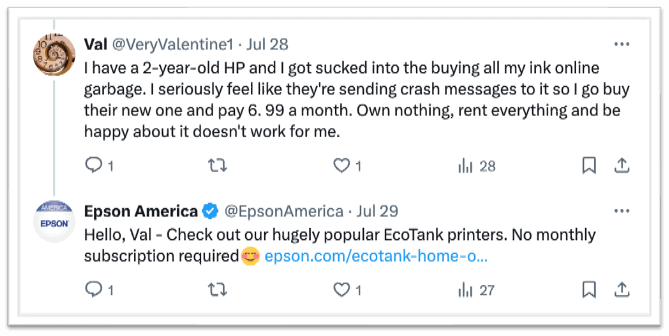
In case you were wondering, that’s Epson using social intelligence (and probably social listening) to answer HP customer complaints faster than HP.
It’s the difference between waiting for someone to knock on your door … and rolling out the red carpet before they even arrive.
Moving from Reactive to Proactive Engagement
Instead of waiting for customers to complain or ask for help, you can use social intelligence to anticipate their needs and reach out proactively.
That’s what Epson did in the example above! I promise you, it’s not that hard when you have a social listening plan that includes competitor listening.
Most brands think they’re “listening” on social, but let’s be real—they’re only tuning in when someone mentions them directly. That’s like eavesdropping on a conversation only when your name is mentioned.
You’re missing the bigger picture!
At B Squared Media, we listen smart. And I’m about to give you our tried-and-true strategy …
Our BIC Social Listening Strategy ensures brands capture everything that matters by monitoring three key areas:
- Brand Keywords – What are people saying about you, with or without mentioning your brand’s handle on social media?
- Industry Keywords – What trends, challenges, and customer pain points are emerging in your space?
- Competitor Keywords – How are your rivals being talked about (or complained about)? What opportunities are they missing?
Why does this matter? Because the most important conversations don’t always happen in your mentions. If you’re only tracking @mentions, you’re missing:
- Buying signals (ex: “What’s the best printer for a small business?”)
- Customer frustrations (ex: “Ugh, my WiFi router keeps dropping! Need a new one.”)
- Competitive insights (ex: “I love X brand, but their customer service is awful.”)
With BIC, we don’t just listen—we turn insights into action. We use this data to shape marketing, refine messaging, boost sales, and improve customer experience.
And now you can too!
Leveraging Customer Conversations for Sales
Not every social media comment is just idle chatter. Some are basically customers waving their wallets in the air.
Phrases like “looking for recommendations” or “best product for” aren’t just small talk—they’re buying signals. And the brands that know how to spot them (and respond fast) are the ones turning casual conversations into real sales.
Because in social selling, timing is everything. Show up at the right moment, and you’re not just part of the conversation—you’re closing the deal.
Or don’t and … you get the idea! (See also: YIKES!!)
Identifying Buying Signals in Social Discussions
Social conversations are a goldmine of acquisition and retention opportunities. The key? Finding, labeling, and quantifying them.
Every comment, mention, or untagged discussion falls into one of two categories:
- Acquisition (GAIN) – New customers asking about recommendations, comparing products, or showing interest in making a purchase.
- Retention (RETAIN) – Existing customers seeking support, sharing feedback, or considering a competitor.
By auditing and tagging these conversations correctly, you can measure just how much of their social chatter is tied to sales potential and customer loyalty. And once you know the breakdown, you can allocate resources to convert leads and keep customers happy.
Because social isn’t just a branding tool, y’all! It’s a direct revenue driver when you know what to look for.
And, don’t forget to check your ads! Marketers who ignore buying signals in paid ads: WHAT ARE YOU DOING?!
Let me get this straight … you’re paying to put ads in front of potential buyers, literally spending money to drive sales … and then when someone comments with a question about purchasing, you ignore them?!
MAKE IT MAKE SENSE.
If someone asks, “Does this come in blue?” or “Is there free shipping?” under your ad, that is a BUYING SIGNAL. That’s someone actively considering handing you their money.
And when you ghost them? You’re handing that sale to a competitor instead.
You wouldn’t leave a customer standing at the checkout counter with their wallet open—so why are you doing it on social?!
Here’s the fix:
- Treat ad comments like a sales floor; if someone’s asking, they’re interested.
- Respond fast! Social moves at lightning speed, and hesitation kills conversions.
- Use smart social listening (like B Squared Media’s BIC method) to spot buying signals beyond direct mentions.
Because if you’re paying for attention but ignoring the people ready to buy, you might as well be lighting that ad budget on fire.
Engaging with Intent-Driven Users
Social selling teams can integrate social media intelligence tools to track potential buyers and engage them with personalized offers, discount codes, or valuable content that nudges them toward a purchase.

See how Sprout steps in and joins the conversation – after a stellar recommendation from me, of course.
By the way, that’s, uh, literally what we do for our social care clients – help them close deals! 😉
Enhancing Customer Experience and Retention
Customers are constantly telling brands what they love and what drives them nuts. The real question is: Are you actually listening?
Social media intelligence goes beyond surface-level feedback, uncovering frustrations, desires, and unmet needs in real time.
The brands that pay attention don’t just fix problems—they proactively improve experiences, boost satisfaction, and turn customers into lifelong fans.
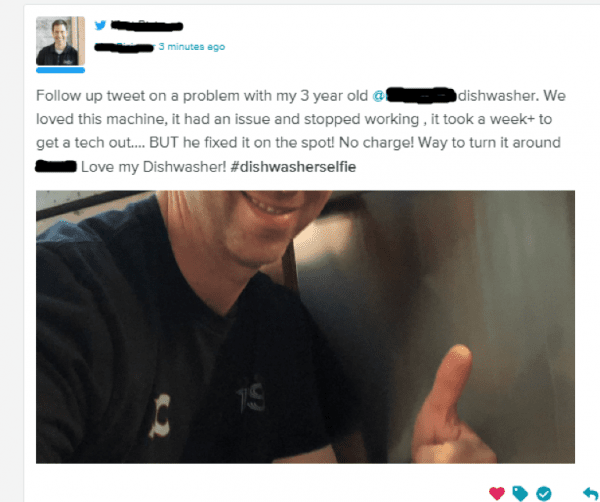
[Source: One of our amazing client’s amazing client]
Because retention isn’t about reacting to complaints! It’s about making sure customers never have a reason to leave in the first place.
Social Media Intelligence for Product Development
Want to know what your customers really want? They’re already telling you.
Social conversations are a treasure trove of product feedback! People are out there discussing what they love, what’s missing, and what they wish your product could do.
The brands that listen? They don’t guess what to build next—they know.
We saw this with a celebrity jewelry brand we once worked with.

Once we figured out who their buying audience was, we were able to quantify which products they asked about the most. Turns out it was a silver necklace … but the client didn’t make it — or any jewelry for that matter — in silver.
When they did? They sold out almost immediately. That’s because they listened and they acted on the social media intelligence our team was able to extract from that social listening project.
By tapping into real-world insights, you’re not just improving your offerings—you’re creating exactly what your audience is asking for.
And that’s how you turn customers into brand evangelists!
Social Media Intelligence That’s Data-Driven & Deeply Personal
LISTEN UP. Social media intelligence isn’t just about hearing what people say—it’s about knowing exactly what to DO with that information.
Businesses that use data-driven insights don’t just respond, they lead. They personalize customer interactions, drive revenue, and outmaneuver the competition.
And that’s where B Squared Media comes in. This isn’t just what we do—it’s all we do. We turn conversations into conversions, insights into strategy, and engagement into long-term customer loyalty.
If you’re not leveraging social intelligence the right way, you’re leaving money—and customers—on the table. Let’s fix that!
FAQs
1. How does social media intelligence differ from social listening?
Social listening tracks mentions and/or keywords, while social intelligence analyzes data to uncover trends, predict behavior, and drive action.
2. What tools can businesses use for social media intelligence?
Popular tools include Sprout Social, Emplifi, Sprinklr, and Talkwalker, among others.
3. How does AI enhance social media intelligence?
AI helps process vast amounts of social data, detect sentiment, and predict customer behavior with greater accuracy.
4. Can social media intelligence help in crisis management?
Yes! Businesses can detect potential PR crises early and address them before they escalate.
5. What industries benefit the most from social media intelligence?
Retail, travel, finance, healthcare, and tech industries benefit greatly from social intelligence insights.
Latest posts by Brooke B. Sellas (See All)
- Ready To Find Your Marketing Magic? Take Our Quiz! - November 19, 2025
- Social Media Customer Psychology: Understanding Expectations Elevates Social Care - November 12, 2025
- Seeking A Social Media Mentor? How To Find The Right One To Help You Boost Results That Matter - November 5, 2025
